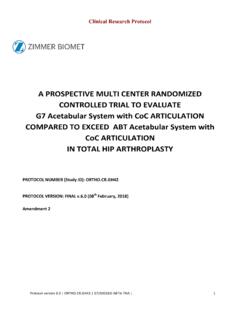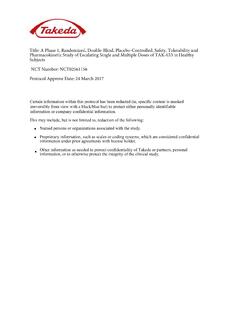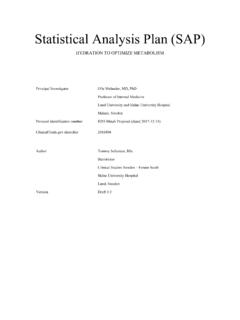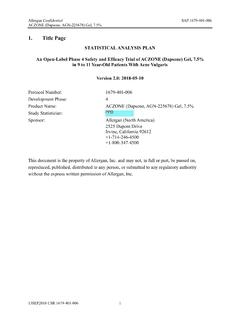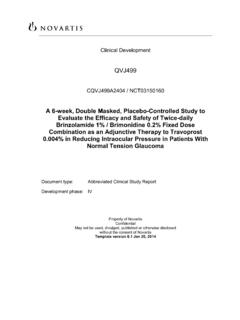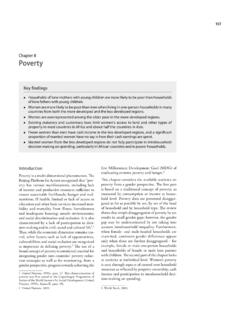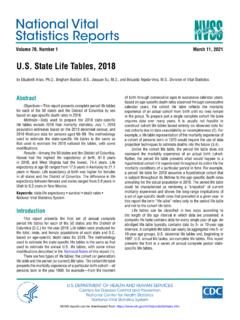Transcription of DETAILED STATISTICAL ANALYSIS PLAN (SAP)
1 STATISTICAL ANALYSIS plan Simple Intensive Care Studies-I 1 DETAILED STATISTICAL ANALYSIS PLAN (SAP) 1. Administrative information Title, registration, versions and revisions Full study title A prospective observational study on the value of conventional hemodynamic parameters in estimating cardiac output and predicting mortality in critically ill patients Acronym Simple Intensive Care Studies-I (SICS-I) Local project number 201500144 number NCT02912624 Study protocol version (23 September 2016) SAP version (3 April 2018)
2 SAP revision history None SAP revision justification - SAP revision timing Revision will be conducted after publishing the two main manuscripts. This revision will concern DETAILED SAPs for each sub-study. STATISTICAL ANALYSIS plan Simple Intensive Care Studies-I 2 Roles and responsibility Author Bart Hiemstra1 Statistician Ilja M. Nolte2 Principle investigator Iwan van der Horst1 Contributors and roles Pim van der Harst3: revised the SAP Frederik Keus1: contributed to the design and revised the SAP Harold Snieder2: revised the SAP Chris HL Tio2: main contributor to the section missing data Jos N Alves Castela Cardoso Forte1: drafted the section additional analyses: machine learning J rn Wetterslev4: contributed to the design and revised the SAP.
3 Main contributor to the sections sample size, power, and detectable difference and STATISTICAL significance and multiple testing Affiliations 1. Department of Critical Care, University of Groningen, University Medical Center Groningen, Groningen, The Netherlands 2. Department of Epidemiology, University of Groningen, University Medical Center Groningen, Groningen, The Netherlands 3. Department of Cardiology, University of Groningen, University Medical Center Groningen, Groningen, The Netherlands 4. The Copenhagen Trial Unit (CTU), Centre for Clinical Intervention Research, Copenhagen, Denmark STATISTICAL ANALYSIS plan Simple Intensive Care Studies-I 3 Signatures We the undersigned, certify that we read this SAP and approve it as adequate in scope of the main- analyses of the SICS-I.
4 Author Name: .. Date: Statistician Name: .. Date: Principle investigator Name: .. Date: STATISTICAL ANALYSIS plan Simple Intensive Care Studies-I 4 2. Introduction Background and rationale About one-third of all critically ill patients suffer from circulatory shock, which places them at increased risks of multi-organ failure, long-term morbidity, and mortality (1,2). Combinations of clinical, haemodynamic and biochemical variables are recommended for establishing the diagnosis and instigation of treatment (3,4).
5 If necessary, more advanced and sequential haemodynamic assessments using critical care ultrasound (CCUS) as preferred modality are recommended (3-6). Clinical examination in the critically ill comprises frequent measurement of heart rate, blood pressure, body temperature, skin perfusion, urine output and mental status (3). Daily use of clinical examination (in any patient) for diagnostic purposes contrasts with the limited number and quality of studies, so that the level of evidence for use of clinical examination in the critically ill is considered best practice (3).
6 Previous studies have suggested different prognostic or diagnostic variables and many studies have analysed single or dual variable associations, while no research has evaluated their additional value on top of the accepted predictors (7). The reason for inconsistency of results in these studies potentially originate from several methodological flaws, including improper research design, lack of confirmation cohorts, and power and sample size issues. The additive diagnostic and prognostic value of combinations of clinical, biochemical and haemodynamic variables remains to be established with a higher quality of evidence.
7 These variables have never been evaluated collectively in a large, broad, prospective cohort of critically ill patients. Therefore, we established the Simple Intensive Care Studies I (SICS-I) with the aim to evaluate the diagnostic and prognostic value of a comprehensive selection of clinical and haemodynamic variables in the critically ill (7). Prospective registration of protocols of observational studies are promoted to prevent outcome reporting bias (8,9). Likewise, prospective publication of a DETAILED STATISTICAL ANALYSIS plan (SAP) is encouraged to prevent data-driven analyses (9-11).
8 Objectives Objectives and research questions The objective of the SICS-I study was to establish a cohort with a dual aim: to evaluate the (1) diagnostic and (2) prognostic value of a comprehensive selection of clinical examination, haemodynamic and biochemical variables in the critically ill. More specific, the two research questions of the basic study were (1): which combination of clinical examination findings is associated with cardiac index measured STATISTICAL ANALYSIS plan Simple Intensive Care Studies-I 5 with CCUS?
9 And (2): which combination of clinical examination, haemodynamic and biochemical variables is associated with 90-day mortality ? In the basic study of the SICS we collected a broad number of clinical examination, haemodynamic and biochemical variables, and used CCUS to only measure cardiac output. The infrastructure and design enabled (temporarily) addition of sub-studies in which additional variables were collected. Research questions of the sub-studies all address the overall aim of the SICS-I cohort (table 1). Hypotheses The hypothesis of research question 1, the diagnostic study, are: Null hypothesis: there is no true correlation between any single or a combination of clinical examination findings and cardiac index measured with CCUS Alternative hypothesis: cardiac index measured with CCUS is associated with one or a combination of clinical examination findings The hypothesis of research question 2, the prognostic study, are: Null hypothesis.
10 Clinical examination, biochemical and haemodynamic variables are not associated with 90-day mortality Alternative hypothesis: clinical examination, haemodynamic and biochemical variables are associated with 90-day mortality Scope This SAP will be the guiding document for the analyses that will be conducted in the basic study. We intend to present the results of the two primary aims in separate manuscripts. All the aims and research questions of the sub-studies will be included in the appendix of this SAP, and we aim to present the SAPs of the sub-studies as an addendum in the future.

